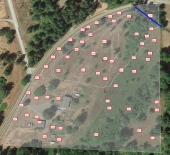James Colbert wrote:You could plant vetiver grass. It grows almost anywhere, stops run off and silt dead in its tracks. A swale will naturally form on the up hill side not to mention vetiver's 12+ foot roots will help you store a bunch of water deep underground fairly quickly. Vetiver grass roots can establish quickly growing to 6 feet in under 6 months. So the benefits are: no digging; quick establishment and sequestration of runoff; non-invasive (it sends dense, fibrous, roots straight down so it won't harm plants around it) and it produces a a renewable mulch and fodder very quickly.
If your willing to dig as well as plant vetiver you can produce a highly effective swale in a short period of time.
Hope this was helpful!
James, that looks really interesting, but I don't think that will work in my area of choice, it being about a 200 day growing climate. It looks like a great grass for many tropical permaculture situations. Unless this grass also grows in colder regions....
I should have specified the situation. Annual rainfall 40+ inches, 1-10% slope, zone 6. Water is sufficient, over most four month periods, though there might be a month of no significant rain. When planting a new tree, it might need to have a way to maximize that water for a couple years. I do not want to have to irrigate a tree, I an planning several hundred, and irrigation would just be too much hassle.









